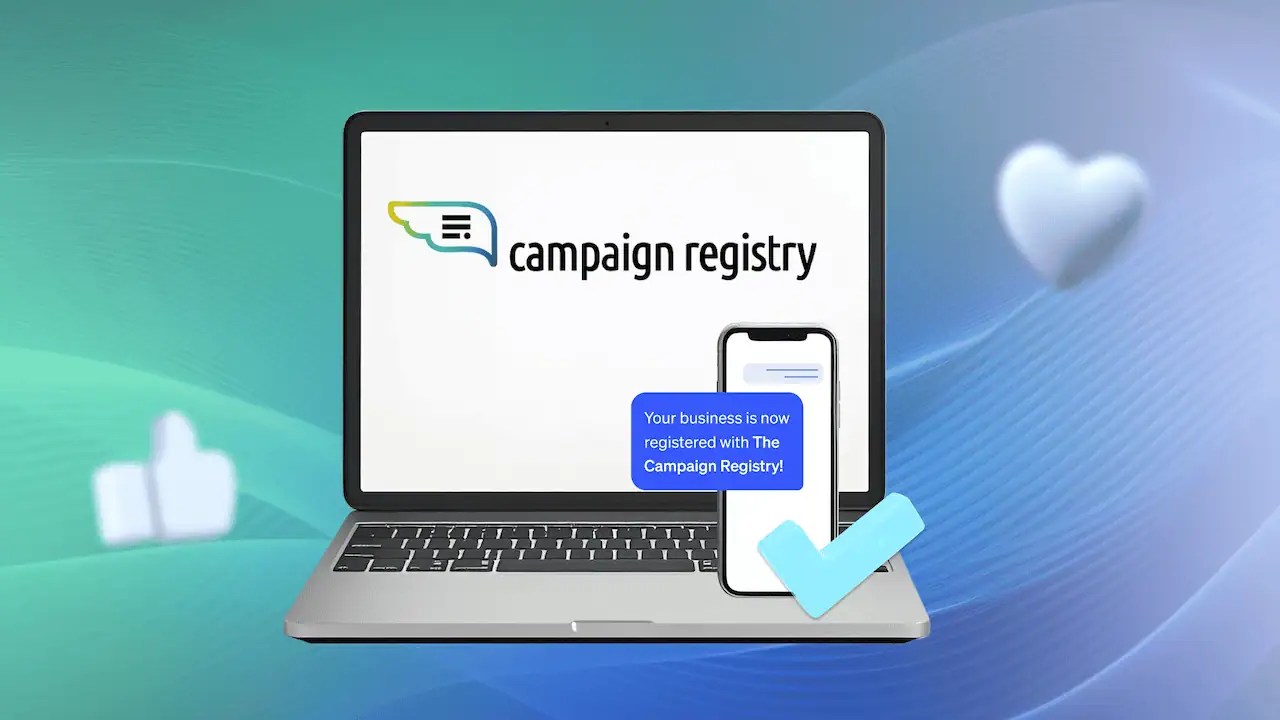How well do you really know what’s happening in your call center? Many businesses struggle to gather and act on meaningful insights into agent performance and customer satisfaction. Call center monitoring closes this gap, turning customer data into actionable information to improve performance and the customer experience.
However, effectively monitoring your call center’s operations is a big challenge. This guide will walk you through the complexities of call center monitoring. We’ll first cover the basics: what it is and why you need it, and then offer some strategies and best practices for aptly implementing quality monitoring in your call center.
What Is Call Center Monitoring?
Call center monitoring involves systematically observing and analyzing customer interactions to assess agent performance, identify training gaps, improve service quality, and optimize the customer service experience using call center software and tools. This is done in real time, with supervisors or quality analysts listening to live calls to provide agents with immediate feedback or assistance.
The process also includes analyzing recorded calls to evaluate call center performance, identify trends, spot agent training and coaching opportunities, and ensure compliance with quality standards. A key aspect of call center quality monitoring is data analysis. Call center quality assurance software and analytics tools extract insights from call data, such as customer sentiment, call duration, and agent efficiency. Businesses can use this data to inform key decisions.
Call center monitoring establishes consistent standards for customer service, helping agents deliver high-quality experiences.
For more information about the basics of call center monitoring, here’s a helpful resource.
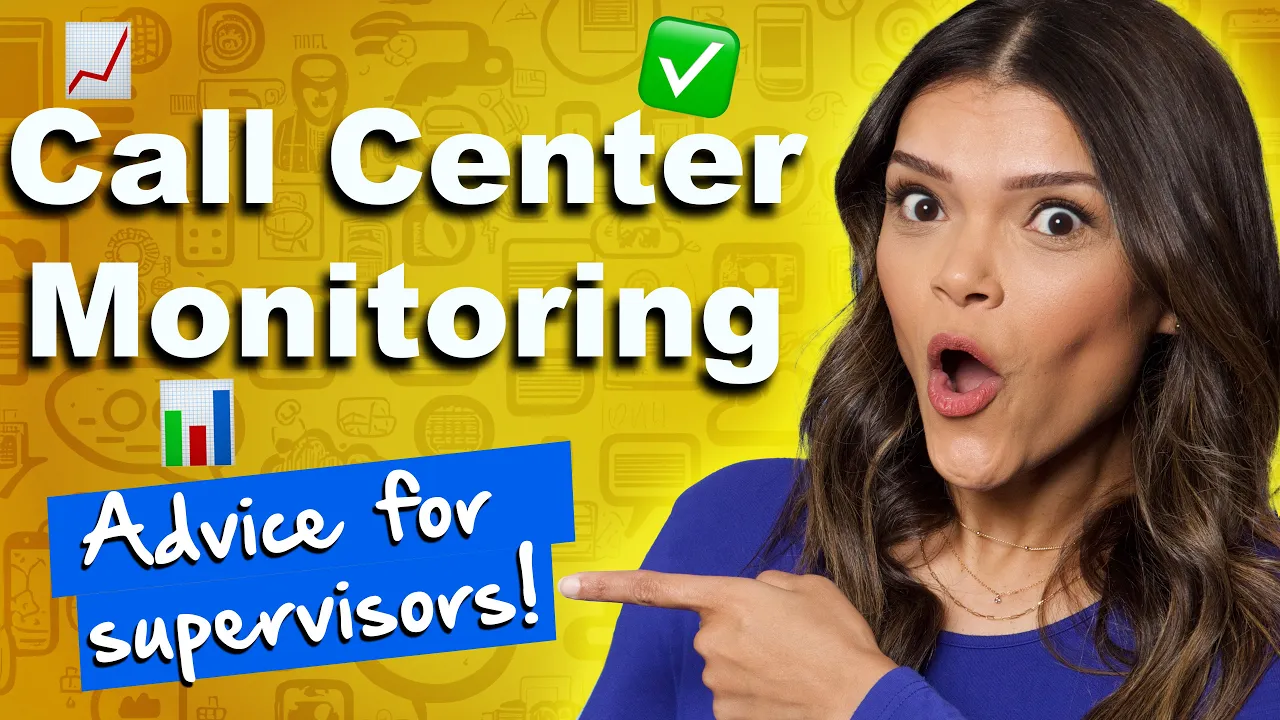
Why Is Call Center Monitoring Important?
Call center monitoring offers many benefits to businesses that want to improve the customer experience and help their agents succeed. Listening to and analyzing customer conversations enables companies to identify problems, improve customer service experience, and ensure compliance.
The benefits are measurable: According to McKinsey & Company research (2023), regularly monitoring calls can improve agent productivity by 15% while increasing customer retention scores by 20%. Knowing what works and what doesn’t informs meaningful improvements that benefit both customers and employees. Here’s how:
Monitoring calls enhances customer experience
Call center monitoring provides direct access to your customer’s voice and perceptions of your brand. Regularly monitoring call center calls enables businesses to identify recurring customer issues, understand common frustrations, and identify opportunities to improve customer service quality.
For example, you can respond proactively if multiple customers are experiencing issues with a particular product feature. However, you can act in time only if you know that customers are encountering these issues in the first place. Call center monitoring helps you identify exactly that.
Call center monitoring also shows how well your agents handle customer service interactions. Are they empathetic? Do they resolve issues efficiently? Do they provide accurate information? These insights help you tailor their training and coaching to create positive customer interactions and encourage customer loyalty and referrals.
It helps build and improve agent performance
Call center monitoring turns raw interactions into learning opportunities. Analyzing recorded calls enables call center managers to provide agents with specific, actionable feedback. This targeted coaching empowers agents to identify their strengths and weaknesses and spot areas for improvement.
For instance, if an agent struggles to calm disgruntled customers, monitoring can show specific moments where they could use different techniques. Likewise, quality monitoring can identify agents who excel in certain areas, and you can share their best practices with the rest of the team. Call monitoring and coaching create a growth-oriented culture, so agents can consistently deliver high-quality customer service.

Compliance and data protection become easy
Call centers need to follow different industry and legal regulations. Many industries, such as finance and healthcare, have strict rules when it comes to data protection, call recording, and customer calls.
Call center monitoring ensures agents follow important rules and call center best practices, which reduce the risk of costly fines and legal consequences.
Quality monitoring makes measures such as obtaining consent before recording calls and securely handling sensitive data second nature. It simplifies detecting and preventing fraudulent activities, protecting your business and customers.
Monitoring encourages data-driven decisions
Businesses use contact center monitoring to aggregate and analyze customer data to make strategic, informed decisions. They get insights into different customer issues, trends, and patterns.
Suppose many customers call about a specific product defect. You could easily initiate a product recall. Or, if you notice that customers repeatedly ask for a feature your product is missing, you can adjust your product development strategy accordingly.
Call monitoring data also gives an insider into customer preferences. It helps you adapt your marketing strategies, improve the customer experience, optimize contact center operations, and drive business growth.

What Call Interactions and Data Do You Monitor?
What exactly is monitored during a call center call? Here are the call types and the data monitored as part of call center quality assurance:
Inbound calls
Inbound calls are those made by customers seeking assistance, information, or support. Monitoring these calls helps businesses identify customer needs and common issues and assess the quality of their customer service. Inbound calls include technical support requests, billing inquiries, sales questions, and customer complaints.
Outbound calls
Agents make outbound calls to customers for various purposes, such as sales, marketing, and follow-ups. Businesses can monitor these calls to measure agent performance, script adherence, professionalism, and overall results. Some examples of outbound calls include sales calls, customer surveys, appointment reminders, and collection calls.
Internal calls
Businesses also generate internal calls for training, team meetings, and internal support requests. Monitoring these internal calls improves communication and enhances training effectiveness and internal processes.
Customer sentiment
Call center monitoring assesses customer sentiment based on the customer’s emotional state during the call. The tone of voice, word choice, and pauses help supervisors identify sentiment. Customer sentiment analysis also shows areas where agents can improve their communication and empathy skills.
Agent performance metrics
Call centers monitor many key performance indicators (KPIs). Here are a few examples
- Average handle time (AHT): The average time it takes to handle a single call.
- First call resolution (FCR): The percentage of requests successfully resolved on the first contact.
- Call transfer rate: The frequency of calls being transferred to other agents or departments.
Together, these metrics provide key information about agent productivity and performance efficiency. Some other call metadata like call duration also helps see calling patterns, trends in call volume, and customer behavior.

Compliance data
Compliance data is information collected as part of contact center monitoring. It demonstrates compliance with legal and regulatory requirements, including proper disclosure of information, secure handling of sensitive data, and adherence to key call recording rules.
Call Center Monitoring Tools and Solutions To Use
Successful call center monitoring requires using the right systems and technology. The following call center monitoring systems give businesses a wealth of insights, improve processes, and create a better customer experience.
Call recording software
Call recording software is a valuable and secure record of all interactions. You can use customer data from the recording software for quality assurance, employee training, and regulatory compliance. Modern call recording solutions offer automated recording, secure storage, and easy access to recordings on demand.

Speech analytics
Speech analytics uses AI to transcribe call content and pinpoint keywords, phrases, and customer sentiment. Businesses get a clear picture of customer concerns, emerging trends, and agent performance, which all help deeply understand customer experience.
Quality management (QM) software
Quality management software is a go-to tool for many businesses to optimize their call center quality assurance processes. These platforms offer many features, including employee evaluation tools, performance dashboards, and coaching. Call center managers use the QM software to receive targeted feedback to improve their employees’ skills.
The software also automates many manual quality assurance tasks, freeing managers to focus on coaching and development.

Workforce management (WFM) software
Workforce management software ensures your call center has enough staff to handle incoming calls. WFM software helps optimize staffing and scheduling. Forecasting and planning tools allow you to predict call volumes and create efficient agent schedules.
The right WFM tool ensures the right number of agents are available at the right time, minimizes wait times, and improves customer satisfaction.
Real-time monitoring dashboards
Real-time monitoring dashboards are key to monitoring ongoing call center operations. Call center supervisors get live visibility into incoming calls, agent activity, and other key metrics to identify and resolve issues quickly. They can also monitor call queues and agent availability to keep contact centers running smoothly.

Customer feedback tools
Customer feedback tools like post-call surveys, feedback forms, online reviews, and social media monitoring are essential for businesses to understand customer perceptions and improve their products or services. These tools capture real-time customer feedback, provide structured opportunities for sharing experiences, and give unfiltered customer opinions.
With customer feedback tools, businesses can better track customer satisfaction, identify improvement trends, identify common pain points, and develop proactive decisions and strategies.

How To Conduct Call Center Monitoring
You have multiple ways to monitor call center calls, offering unique insights and benefits. Businesses typically use the following monitoring methods to understand their call center operations.
Live monitoring
With live monitoring, supervisors can directly observe real-time agent-customer interactions, and get immediate insights into performance and call quality. When needed, they can also intervene to offer on-the-spot coaching, ensure agents follow protocols, and quickly address escalated concerns before they impact customer experience or company reputation.
Beyond immediate intervention, live monitoring is a great development tool. Analyzing interactions lets supervisors identify agents’ strengths and weaknesses and tailor coaching programs to individual needs. This targeted approach enhances agents’ skills and confidence to deal with customer issues effectively.

Post-call analysis
Post-call analytics forms the bulk of call center quality assurance. Call center managers evaluate recorded interactions to understand agent performance and the customer experience. They can also gauge communication skills, protocol adherence, problem-solving skills, and customer satisfaction in a methodical review process.
Using post-call analysis, businesses can see patterns in customer inquiries and gaps in their call center performance and create targeted training programs that address key pain points. Unlike live monitoring, post-call analysis offers supervisors deeper insights to replay interactions and identify hidden nuances. This method also reduces observer bias with a complete view of the customer journey across touchpoints.
Automated quality assurance
Automated quality assurance uses speech analytics and AI tools to handle high call volumes efficiently. It identifies keywords, sentiment patterns, and key metrics for customer experience and agent performance trends. Automation enables consistent, objective evaluation of all interactions while highlighting key areas for agent development.
Advanced automated quality assurance systems also offer scalable compliance monitoring and predictive analytics to automatically flag regulatory violations and script deviations in real time. This reduces compliance risks across thousands of interactions.
Automated QA eliminates human evaluation bias, standardizes scoring across all agents, and provides quantifiable metrics that directly connect agent performance to your call center’s performance.

Call Center Monitoring Best Practices
Effective call center performance comes down to following some call monitoring best practices:
Set clear objectives and metrics
Start with the goal. Determine what you want to achieve with your quality monitoring process — increasing customer satisfaction, improving agent performance, or reducing handle times. Then, identify the call center metrics that’ll tell you about your progress. These could include first-call resolution rates, customer sentiment, or script adherence. Help your team understand what success means, so they can work together toward clear goals.
Ensure your performance metrics are balanced and aligned with your key business goals. Too much focus on speed metrics can compromise quality while overemphasizing quality without considering efficiency can hurt your bottom line.
Review your goals quarterly to ensure they’re relevant and achievable. Involving frontline agents and call center employees in setting these metrics can increase adoption and provide key insights from agents closest to customer interactions.

Use a multi-faceted call monitoring strategy
Don’t put all your eggs in one basket. Combine different monitoring methods to measure your call center’s performance. Live monitoring helps you identify real-time problems, post-call analytics show patterns over time, and automated QA tools can efficiently review large call volumes. A balanced approach adds depth and breadth to your quality assurance program.
Consider rotating your live monitoring schedule so that all customer service agents receive attention on different days and at different times. You’ll better identify performance fluctuations throughout the day or week.
Also, develop a structured evaluation form for post-call analysis that standardizes the review process. Use automated customer service to flag calls with specific triggers — such as long periods of silence or heightened emotions — for human review. Creating intelligent workflows with a mix of human and automation maximizes your quality team’s time and effectiveness.

Improve through customer and employee feedback
Provide one-on-one feedback. Regular call center coaching should feel like conversations, not criticism. Share concrete examples of what employees have done well and where they can improve. Create individual development plans and celebrate progress. When agents see monitoring as a growth tool, they become partners in the improvement process.
Peer learning can effectively complement feedback from supervisors. Consider implementing a call center monitoring system where high-performing agents regularly share their call-handling techniques with the team. This not only disseminates best practices but also recognizes your top performers.
Also, allow agents to self-assess by listening to their own calls. Self-awareness is the first step toward improvement, helping agents identify areas they’ve missed or overlooked even with careful monitoring. Create an environment where everyone is committed to quality improvements.
Invest in the right communication technology
Equip your team with the right tools for the job. Advanced call recording software, speech analytics platforms, and quality management systems offer customer-centric insights. Stay transparent with your team about how and why you’re monitoring calls. When agents understand the purpose of monitoring, they’ll embrace it rather than resist it.
Beyond simple call recording, consider integrated contact center software that connects monitoring data with other systems, such as your CRM or knowledge base. Integrated technologies help identify correlations between call quality and other business outcomes.

When checking out new technologies, involve your call center agents or reps in the selection process. They often identify practical issues or benefits that management misses. Budget for adequate training too. Even the best technology falls short when users don’t understand how to benefit from its capabilities.
Monitor customer feedback and adapt your strategy
Analyze customer sentiment. Collect feedback through post-call surveys, social media mentions, and other channels to understand the customer experience from the customer’s perspective. Review this feedback regularly alongside your internal metrics and adapt your monitoring approach to changing customer expectations. The most effective monitoring programs remain flexible and respond quickly to changing customer needs.
Compare customer feedback to internal quality assessments to identify perception gaps. Sometimes customers are dissatisfied even on calls that meet all internal quality standards. This indicates that you need to review your quality management criteria.
Consider establishing a “Voice of the Customer” committee that meets monthly to analyze trends and recommend adjustments to your monitoring focus. Focus on customer experience. If you identify emerging issues in customer feedback, adjust your monitoring criteria to address them before they become widespread problems.
Top Call Center Monitoring Software
Now let’s look at the top call center software to support your quality management and monitoring process:
1) Nextiva Call Center
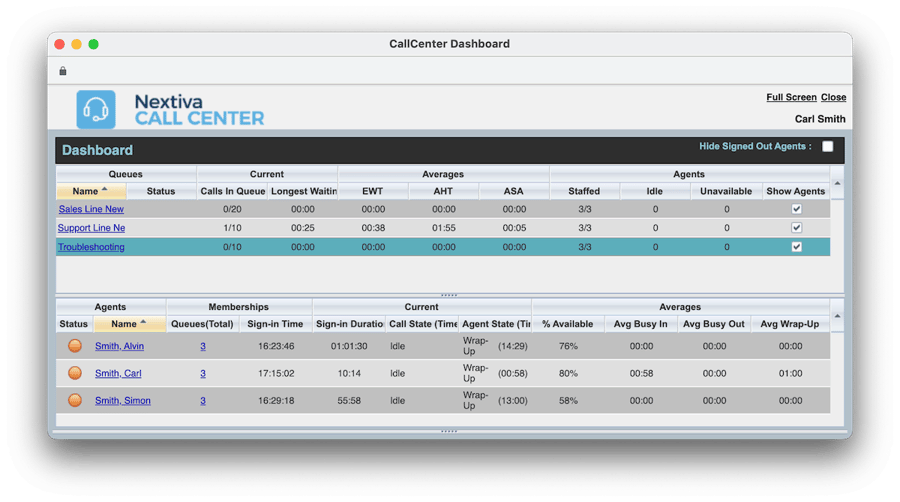
Nextiva offers complete call center technology tailored to small and medium-sized businesses seeking rapid implementation and immediate impact. The platform features omnichannel capabilities, seamlessly handling inbound routing, web chat, email, and social media interactions, so you can reach your customers wherever they prefer to interact.
Key Nextiva features
- Real-time and post-call monitoring: Access live monitoring and call recording through an intuitive online interface.
- Performance evaluation tools: Grade agent interactions through targeted selection or random sampling to eliminate bias.
- In-call coaching: Use the discrete barge-in feature to provide your agents real-time assistance with difficult conversations without the customer hearing.
- Escalation management: Let supervisors intervene and join the conversation or take full control if needed.
Security and Integration
Nextiva offers built-in compliance with key regulations like HIPAA, PCI, and CCPA, enabling immediate implementation without time-consuming security audits. The integrated cloud phone system creates a unified environment where you can monitor internal and external communications through a single platform.
Best for
Businesses that want an intuitive, feature-rich user interface and a simple, unified approach across all business communications.
2) Five9 Contact Center

Five9 is a future-oriented contact center solution focused on artificial intelligence and automation. It’s built for businesses looking to eliminate manual processes and focus more resources on human value-added activities, Five9 offers impressive features that align current needs with future innovations.
Key Five9 features
- AI-optimized customer experience: Provides 24/7 self-service chatbots and sophisticated predictive analytics.
- Comprehensive monitoring tools: Offers real-time call monitoring with intuitive color-coding to identify monitored agents.
- Screen recording: Captures both audio and video elements of agent interactions to determine call quality and workflow efficiency.
- Performance analytics: Identifies workflow bottlenecks, such as agents struggling to find resources or navigate user interfaces.
Best for
Businesses ready to implement AI-powered call center operations to balance robust monitoring capabilities and advanced artificial intelligence.
3) Enthu.ai
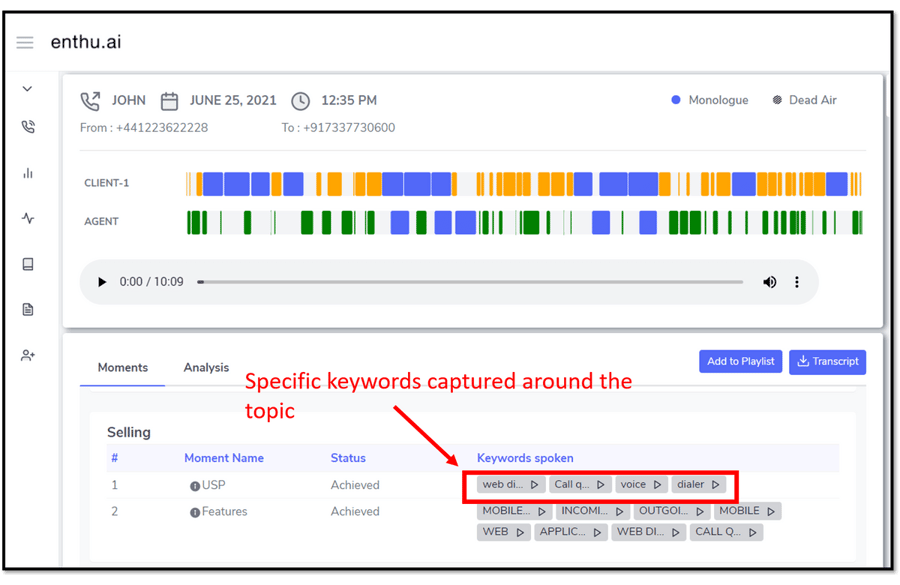
Unlike comprehensive contact center solutions, Enthu.ai is a specialized quality automation platform for sales teams. It uses artificial intelligence to capture and automatically analyze customer interactions across multiple channels. The call center platform drives targeted sales training, supports the development of more effective sales materials, and provides valuable feedback for product management teams.
Key Enthu.ai features
- AI-powered analytics: Monitors conversations based on specific keywords and identifies upselling opportunities and key resolution moments.
- Multi-channel tracking: Automatically evaluates phone calls, voicemails, webchats, and video messages.
- Visual reporting: Provides clear charts and graphs that highlight opportunities for upselling, cross-selling, and contract renewals.
- Integration flexibility: Works with established communications platforms like Webex to extend functionality across existing technologies.
Best for
Teams looking for an autonomous quality monitoring process that works in the background and delivers insights without the need for constant management oversight.
4) Gong
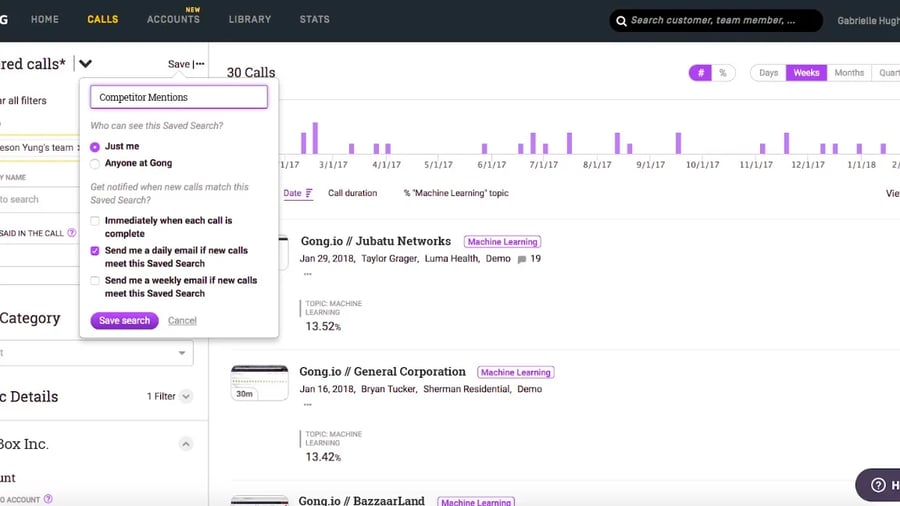
Gong is a leading call recording platform optimized for sales teams. It’s a revenue intelligence platform that generates key insights across different stages of the sales cycle. The platform provides a clear assessment of relationship strength and conversion likelihood, helping sales teams prioritize their efforts and identify coaching opportunities.
Key Gong Features
- Call recording and analysis: Captures and analyzes sales calls to provide insights into customer interactions and sales performance.
- Conversation intelligence: Uses AI to identify patterns, topics, and sentiments in conversations to help understand what works in sales.
- Deal pipeline analytics: Tracks deal progress and provides visibility into the health of opportunities across the sales pipeline.
- Competitor mention tracking: Identifies when competitors are mentioned during calls to help refine competitive positioning.
- Coaching capabilities: Offers tools to help managers provide targeted feedback and training based on real conversation data.
Best for
Sales-oriented organizations that focus on converting customer conversations directly into revenue and transforming interactions into learning opportunities.
5) Insightful
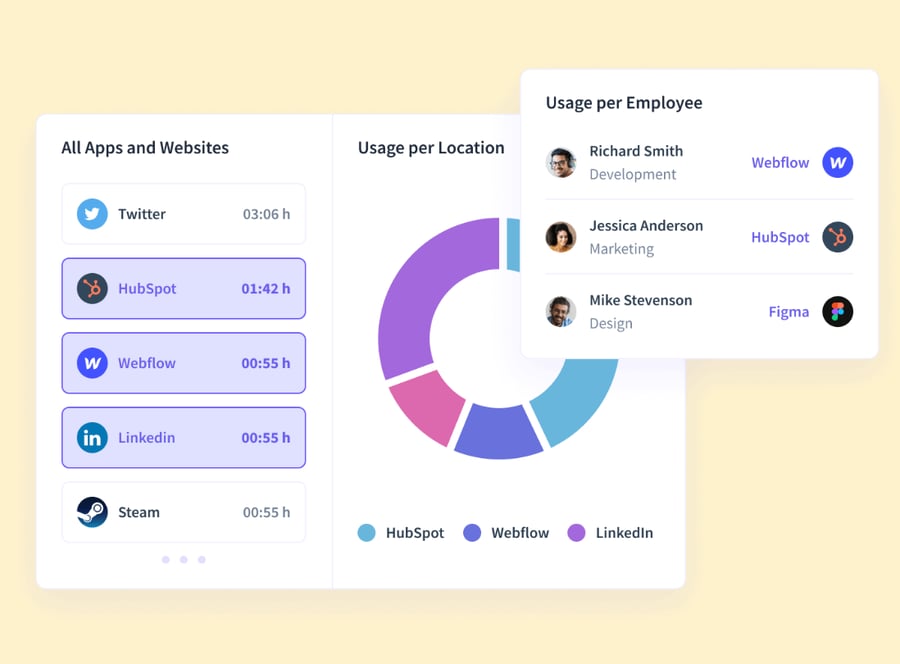
Insightful offers workforce analytics to optimize team productivity. It’s one of the call center services that track key metrics to generate concrete data on workforce utilization and identify opportunities for operational improvement.
Key Insightful features
- Activity monitoring: Tracks active time, break duration, idle time, and manually logged time.
- Application usage analysis: Provides insight into employees’ precise use of digital time.
- Productivity assessment: Generates meaningful metrics for easy performance comparisons.
- Intuitive reporting: Combines high-level overviews with the ability to drill down into details.
Best for
Organizations that need to track internal employee productivity and technology use with a comprehensive and user-friendly workforce insights solution.
How to Choose the Right Call Center Monitoring Software
Consider the following key factors to pick the solution that aligns with your needs:
- Assess current challenges: Identify your most pressing problems — inconsistent customer experiences, high employee turnover, or difficulties meeting compliance standards. The right solution addresses your unique pain points rather than simply offering generic features.
- Define your technology requirements: Evaluate your existing tech stack and identify the necessary integration points. Effective contact center solutions integrate seamlessly with your CRM, ticketing system, and knowledge base, providing unified insights without creating data silos.
- Consider scalability requirements: Choose a platform that can grow with your business. Will you need to support additional channels, expand your team, or integrate advanced analytics in the next 12–24 months? Choose quality management software with the flexibility to scale.
- Evaluate the user experience: Prioritize intuitive interfaces for contact center managers and minimal workflow disruptions for agents. Request demos that illustrate everyday operational tasks rather than simply showcasing highlights.
- Balancing AI and human engagement: Find the right mix of automated analysis and human review for your call center team. While AI can efficiently handle multiple interactions, human judgment is essential for context and nuance in coaching conversations.
Make Monitoring a Strategic Advantage Your Call Center Needs
Effective call center monitoring improves both agent performance and the customer experience. Success begins with aligning your monitoring approach with business goals, such as improving satisfaction scores, increasing first-call resolution rates, or optimizing other key KPIs.
The right call center monitoring software combines key features such as comprehensive recording, intuitive reporting, meaningful analytics, and secure access controls for continuous improvement.
Remember: Effective monitoring isn’t about surveillance but empowering agents. Through regular feedback and targeted coaching, agents develop the confidence and competence that improve the customer experience.
When considering call center software, prioritize solutions that integrate with your existing workflows while offering growth potential. For businesses seeking a complete package, Nextiva offers a comprehensive contact center solution with integrated monitoring that optimizes every interaction.

Nextiva is more than a technology acquisition — it forms the foundation for operational excellence and an exceptional customer experience.
Call Center Tools Your Team Needs.
Monitor your calls efficiently and stay a step ahead of customer needs with Nextiva.
Call Center Monitoring FAQs
Establish a regular rhythm of weekly individual feedback sessions, supplemented by monthly team meetings that highlight both exemplary calls and improvement opportunities. Increase the meeting frequency for new agents to accelerate their learning curve, and gradually transition to the standard schedule as their proficiency increases. Consistency is key. Sporadic meetings diminish the impact, while too frequent meetings can lead to performance anxiety.
While specific priorities vary by business model, a balanced approach includes both efficiency metrics (average handle time, first-call resolution) and satisfaction quality indicators (customer satisfaction scores (CSAT), quality assurance ratings). Avoid the common mistake of overemphasizing individual metrics like call duration. This can tempt agents to rush interactions at the expense of resolution quality. Instead, develop a holistic scorecard that reflects your unique customer experience goals.
Transparency is essential — communicate how monitoring benefits both customers and agents through improved support and development opportunities. Involve agents in setting quality standards and encourage self-assessment of recorded calls before supervisor review. Celebrate improvements and exceptional performance publicly while discussing areas for development privately. This balanced approach makes monitoring a growth and productivity tool, not a punitive measure.
Use AI-powered tools to analyze 100% of all interactions and flag calls that meet specific criteria (emotional escalations, compliance issues, sales opportunities) for human review. Employ a hybrid approach that ensures comprehensive coverage while focusing valuable manager time on the interactions that provide maximum insights. As your quality management process evolves, refine your triggers to improve the signal-to-noise ratio.
Track improvements in key performance indicators directly impacted by effective monitoring, including reduced escalation rates, improved quality scores, increased customer satisfaction, and lower agent turnover. Quantify these improvements by establishing baselines before implementation and monitoring trends over time. For a more comprehensive assessment, calculate the financial impact of improvements such as higher first-call resolution rates (lower operating costs) and improved customer satisfaction (higher customer retention and value).


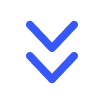














 Business Communication
Business Communication 











